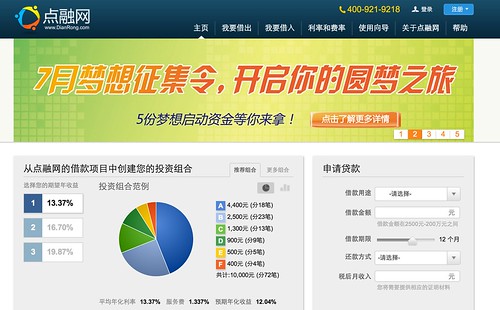One of the areas where I see major disruption happening over the next years is the banking industry. Most major banks are still living in the 20th century and don’t seem to realize that start-ups will turn their traditional industry upside down. Probably many feel are not only too big to fail, but also too big to change. Or more likely, their employees are generally too risk averse to innovate.
I looked at various business models and think that peer to peer (p2p) lending will be a game changer. In the US Lending Club is the leading player in this field and I wrote about them a couple of times already on this blog. They are killing it and got an investment from Google at a $1.55 billion valuation a few months ago. On the secondary market investors are willing to pay even higher prices for their shares right now. I joined the LendIt Conference in New York City in June and was impressed by how quickly the industry is maturing.
In January I was introduced to Soul Htite, co-founder and former CTO of Lending Club. He moved to Shanghai 2 years ago to set up a Chinese version of Lending Club that he called SinoLending (点融网, www.dianrong.com). SinoLending is an online lending platform where members can borrow and lend money among themselves at better interest rates. Borrowers can get loans significantly below market rates, and lenders can earn returns well above those of bank deposits, wealth management products, trust products and other traditional fixed-income investments.
One problem I have encountered many times over the past years, is that companies or individuals are not able to get bank loans. Even if the company is doing well and only needs a temporary loan, the banks are not able (or not willing) to gives these loans. This is a major problem for China’s growth and it’s an important reason why the whole shadow banking industry developed in China. SinoLending can help to solve this problem.
SinoLending’s proprietary and state of the art technology gives the company a huge advantage over traditional banks by reducing the cost of customer acquisition, underwriting, fund managements, bad debt collections, regulatory compliance, and reporting. Better rates and better returns are now a reality in China. As a lender you get returns of on average 15-20% per year, much higher than you get anywhere else, and even a lot higher than I get on my Lending Club loans. Take a look at some of their currently available loans at http://www.dianrong.com/browse/browse. Anybody in China can sign up and immediately invest in loans, even if you just want to put a few hundred Renminbi in.
View from the SinoLending/Dianrong offices in Shanghai
I looked at several China based p2p platforms and think SinoLending is by far the most professional with an excellent back-end system (similar to Lending Club) and a great Chinese management team. Although there is a big regulatory risk in China I believe this company can become the leader in this space because of Soul’s previous experience, because of his strong team and because of their good local connections. Therefore I am happy to announce that after a few months of advising the company I now formally joined the SinoLending board, so I can help the company even better to achieve its goals.
Good luck to the Sinolending/Dianrong team and let’s make this a huge success together!
If you read Chinese, Forbes China had a good article on SinoLending in its issue from July 15.


For lenders (investors) it might be interesting, but for borrowers it is an expensive solution. Financing in itself is not the issue, but the stricter rules of lending money are. Banks should be more clear / transparant about the risk management rules.
Borrowers often have no other options in China. I have seen it with companies that have investments in USD but can’t get them into RMB quick enough, then a short bridge loan can be an important help. Nobody else can give you that in China. Is it expensive? Depends what you use the money for (if your business needs it to survive a temporary liquidity problem it’s not expensive) and what rates you compare it to (credit card rates are much higher for example, and everybody accepts those).
Have also a look at this Belgian initiative: https://www.newb.coop/nl/default.aspx
Marcel, the disruption is about speed and lower cost. However, I heard the p2p borrowers are still very much acquired by agent, one by one. The loan approval process is not straight through, borrowers still have to a physical location to sign loan contract. Where is the cost advantage? Is this p2p a myth in China like many other fake products